Finnish Lapland
Finnish Lapland (Finnish and Sámi: Lappi, Swedish: Lappland) is the Arctic far north in Finland, strictly defined as the province of the same name, but in practice starting near the Arctic Circle. Most Finnish ski resorts are here, as well as the biggest national parks.
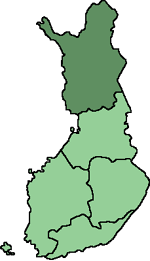
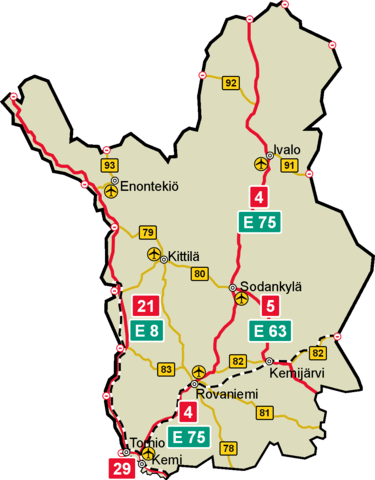
Temperatures can plunge as low as -50°C (-60°F) in the winter and the sun is not seen for days on end during the polar night (kaamos). By contrast, summer brings out the Midnight Sun and temperatures can occasionally rise to 30°C, although summer temperatures in the 10–20°C (50–70°F) are mostly the norm. July is the warmest month.
Destinations
Lapland is divided into twenty municipalities, four of which are called "kaupunki" (town).
Cities
- Rovaniemi — province capital and the only city of any size, at the Arctic Circle, with workshops of Santa Claus
- Kemi — bleak paper industry town best known for Arctic icebreaker cruises for tourists and the world's largest snow castle
- Tornio — small town at the Swedish border. The Swedish half is Haparanda
- Kemijärvi — railhead to the north-east
Municipalities
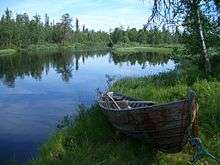
- Enontekiö – the "arm" of Finland (fi: Käsivarsi), with all Finnish fells over 1000 metres high
- Inari – largest municipality, with Lake Inari, three Sámi languages and the Sámi parliament in the village of the same name, the biggest population centre is Ivalo
- Keminmaa – the countryside around Kemi
- Kittilä – airport and the Levi resort
- Kolari – the northernmost railway station
- Muonio
- Pelkosenniemi
- Pello
- Posio – Pentik design and Riisitunturi National Park
- Ranua – wildlife park
- Salla
- Savukoski – most sparsely populated municipality of Finland, with Korvatunturi fell, the real home of Father Christmas far from everything
- Simo
- Sodankylä – Midnight Sun Film Festival and Tankavaara gold panning championships
- Tervola
- Utsjoki – the northernmost municipality; wilderness areas and the salmon river Teno
- Ylitornio
Key destinations and resorts
- Hetta (Enontekiö) — gateway to some northern national parks and wilderness areas
- Inari — the centre of Sámi culture
- Kilpisjärvi — alpine village at the border of Finland, Sweden and Norway, near the tallest fells of Finland
- Levi — winter sports resort, popular especially among young people
- Luosto — ski and safari resort, home to the only open amethyst mine in Europe
- Nuorgam — northernmost village of the EU, border crossing to Norway
- Saariselkä — popular winter sports resort for the older set, gateway to another of the largest national parks in Finland
- Suomu — a ski resort
- Ylläs — small but increasingly popular ski resort
Other destinations
- Lemmenjoki National Park – river valley with gold digging grounds, some fells and vast surrounding wilderness
- Pallas-Yllästunturi National Park – fell range on the border between Forest-Lapland and Fell-Lapland protected as one of the first national parks in Finland, good communications and services
- Riisitunturi National Park – small but nice national park around the fell Riisitunturi
- Urho Kekkonen National Park – national park by Saariselkä and all its services, with vast backcountry, including the home of Joulupukki (Santa Claus)
- Käsivarsi Wilderness Area – including Finland's highest fells
Understand
Lapland is the Wild North of Finland. Outside cities wilderness – with half-wild reindeer – is everywhere. Even by the roads the distances between villages are long and villages on the map may be home only to a few families, some even uninhabited part of the year.
The northernmost municipalities are home of Finland's Sámi people, who for centuries have got their living from this barren region, mainly from fishing, hunting and reindeer husbandry. Here they are a sizeable minority, even majority. Most tourist enterprises – especially those not Sámi – from Rovaniemi onward draw on Sámi culture, offering you invented "genuine" rituals etc. Take it for what it is and just enjoy – or avoid such programmes. Genuine Sámi culture is better experienced in community centres, at cultural events and using services of Sámi tourist businesses (which often do not make any notion about their ethnicity). In southern Lapland the original Sámi population has been integrated with the Finnish and disappeared, but many from the north study or work in Rovaniemi (and also in southern cities).
There is not too much history to see, because at the end of the Second World War, retreating German troops implemented a scorched earth policy to punish their Finnish allies for agreeing to peace with the Soviet Union, razing everything in their path. By the time they were done, 100,000 people had fled, 675 bridges were blown up, all major roads were mined and the capital Rovaniemi had only 13 houses left standing.
But then, people don't come to Lapland for the architecture, they come here for the nature. While there are no craggy mountains or fjords here, the endless pine forests and the treeless rounded fells (tunturi) poking out between them can also be breathtakingly beautiful. Finns talk about the "Lapland fever" because of the many who have lost their heart to this land.
When to go
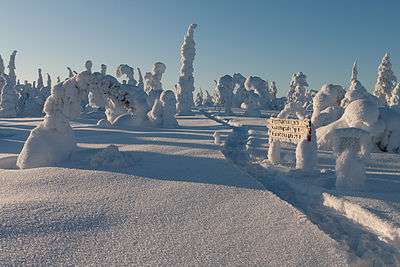
Christmas in Lapland sounds appealing, but this is the time of the Arctic Night; it is dark and it can be very cold (-30°C/-25°F is common). There are businesses happy to arrange meetings with Joulupukki (Santa Claus) in Rovaniemi, or snowmobile or husky safaris, with some luck in the light of aurora borealis, most anywhere. Such organised trips are safe, but independent backcountry adventures require adequate skill and experience.
By the end of February both the weather and the light improve, with temperatures on the better side of -10°C (-15°F) and nearly 12 hours of light a day, although the sun is low and it still feels like perpetual dusk. Most Finns only start to pack in at Easter, when it often is possible to ski in bright sunshine wearing only a T-shirt. It takes quite some time for the accumulated snow (often more than a metre) to melt off, and skiing may be possible as late as May.
In late spring and early summer, the landscape turns muddy as the snow melts, bringing on the curse of the Lappish mosquito and its friends (collectively known as räkkä), and if you think this sounds like a trivial nuisance you have never had to face up to the hordes that inhabit Lapland – do not venture out without industrial-strength insect repellent. Mosquitoes are far less present in the centres of the cities (and above the tree line) but it is virtually impossible to avoid the bite. The mosquitoes' bites are itchy and their noise is irritating, but they spread no diseases.
On the upside, the famous midnight sun is visible almost everywhere in Lapland. Special events are held to celebrate the equinox and the midnight sun. At Rovaniemi the sun doesn't set at all at Midsummer, with this period growing longer as one travels farther north (beginning of June to late July in Utsjoki). Some foreigners have difficulty sleeping during these nightless periods, though a simple sleep mask should go a long way.
By late July the mosquitoes start to die out and they're usually gone by late August. Hiking in the middle of ruska, the colourful time of autumn, is a worthwhile experience.
Talk
The local language is mostly Finnish. Sámi languages are spoken sparsely to commonly in the northernmost areas (Sodankylä, Inari, Utsjoki and Enontekiö). but as everywhere in Finland, you will survive very well with English. Swedish, though official, is rarely spoken in this area, but the closely related Norwegian may be spoken by the border. English is the main option for those who don't speak Finnish. German and other languages might be known at hotels and tourist attractions.
Get in
By plane
Flying is the most practical and fastest means of reaching much of Lapland, but for most destinations services are sparse and prices often steep. There are commercial airports in Hetta (Enontekiö), Ivalo, Kemi/Tornio, Kittilä and Rovaniemi. Best options for airlines are Finnair and Norwegian. Air Baltic flies to Rovaniemi and Kittilä from Riga. The buses mostly drive via the airports. In addition to the regular flights, mostly from Helsinki, there are seasonal flights and charter flights from abroad in season.
By train
Trains will get you to the towns, most notably to the provincial capital Rovaniemi at the Arctic Circle, or to the northernmost railway station in Kolari. The overnight trains from the south have sleepers and also take cars. Most of Lapland is reachable only by bus or car.
If entering from Sweden, there is a gap in the passenger train network before the border at Haparanda/Tornio, but the connecting bus from Luleå is free with Inter Rail and Scanrail. From Russia you can get to Murmansk and continue by bus to Ivalo or get off at Kandalaksha and continue by bus to Rovaniemi.
By bus
There are bus connections from Helsinki to Rovaniemi (15 hours), which is the hub of most connections. Northern Norway (Troms and Finnmark) has daily connections at least in summer. From Sweden, you will probably come via Haparanda/Tornio. From Russia, there are bus connections from Murmansk to Ivalo thrice and from Kandalaksha to Rovaniemi twice a week (check!).
By car
There are good roads to Lapland, but instead of using a day on driving, you might want to get your car on an overnight train and wake up fresh in the morning to enjoy the landscape while driving only the remaining distance – which may certainly be long enough.
If you drive from southern Finland, these routes can be recommended:
- To/from Kemi, Rovaniemi, Kemijärvi, Sodankylä, Ivalo, Inari, Utjoki: E75
- To/from Kolari: E75, E8 through Tornio
- To/from Kittilä, Levi: E75, 79 through Rovaniemi
If you drive through Sweden, these routes can be recommended:
- To/from Tornio, Kemi: E4
- To/from Rovaniemi, Kemijärvi, Sodankylä, Ivalo: E4 and E75
- To/from Kolari, Kittilä, Levi: E10, 392, 403 etc through Pajala
- To/from Inari, Utjoki or Kirkenes (Norway): E75 through Ivalo
- Alternatively through Kolari and route 955, which is 70 km shorter and slightly faster, but the road is of less good quality, more adventurous.
Get around
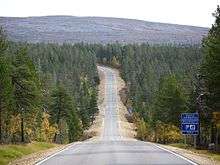
Distances in Finnish Lapland are great and train service extends only to Kemijärvi (a little north-east of Rovaniemi) and Kolari, so the independent traveller will thus have to rely on slightly cheaper but infrequent buses to get around. Hitchhiking is also possible, but can only be recommended during the brief summer season; traffic is sparse even on the main roads. On the other hand the likeliness of getting a lift is quite high once a car passes.
By bus
Long distance buses cover practically all of even the smallest places, often with sparse schedules. They are the cheapest and slowest means of transportation. Although there are bus stops of course, they can also be stopped by hand sign when you happen to meet one as a hiker on a lonely countryside road. Express buses usually turn into normal ones north of Rovaniemi. For some destinations you should look for school buses, postal carriers or shuttle taxis.
By train
Train services are limited in Lapland. Travelling by train is possible from Kemi to Rovaniemi, Kemijärvi and Kolari.
By car
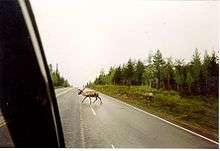
You can reach most places in Lapland by car (yes, there are still villages without road connection!), but traffic even on main roads is sparse and distances are great. Minor roads are sometimes truly minor. Driving in Arctic conditions can be hazardous in winter. Winter tyres (M+S; the formal requirement is enough tread depth) are mandatory from 1 December through the end of February and studded tires allowed to a week after Easter – or longer if needed, err on the side of keeping them on. Use Nordic winter tyres, which are soft enough also at low temperatures. The most dangerous weather is when the temperature is around freezing, when slippery but near-invisible black ice forms on the roads or the icy surface is wet. Do not venture out before you understand the issues, and make sure the windows are clear from snow and moisture.
Stay very alert, particularly at dawn and dusk, for wild animals. Reindeer are a common cause of accidents, while collisions with much larger moose are rarer but very often lethal. If you hit a reindeer, you must always inform the locals (or 112), even if the animal seems to be unharmed, as they will in turn inform the owner of the deer (you won't be charged with anything unless you were drunk or speeding). Bring emergency supplies in case of a collision or breakdown, especially in winter. Locals will help if they can, but you may be in for a long, very cold wait.
Unlike moose, which usually runs to the road suddenly and alone, the reindeer hang around peacefully in groups and collisions are usually easy to avoid if slowing down at once when the first reindeer appear in sight (drive carefully, as they may suddenly regroup in front of the car).
Liikenneturva, the Finnish road safety agency, maintains a Tips for winter driving page in English.
If you are going to rent your car, check availability and prices beforehand. In Rovaniemi and Kittilä there are probably enough businesses, but in the far north you may have to take what is offered.
By snowmobile
In winter there are some 20,000 km of snowmobile routes and tracks in Finland maintained by municipalities or the forestry administration (Metsähallitus), mostly in Lapland. The routes often pass by campfire sites, day huts, reservation huts and other infrastructure in the wilderness (but using open wilderness huts for overnight stay is allowed only for those coming by own muscle).
You need the vehicle, suitable gear, helmets, a driving licence (one for cars or motorbikes is enough) and for some routes a permit. The Metsähallitus permit costs €9/3h, €15/day, €30/week, €50/year, the last covering all family (not independent children). Snowmobiling along roads or off marked routes is not permitted (exceptions for reindeer husbandry etc.), on frozen water driving is free where not specifically restricted (mind ice safety!). Check route maps and driving rules. Drive gently and follow advice, as it is easy for the less seasoned to make fatal mistakes.
Snowmobile safaris are a common programme at tourist businesses. The locals, especially those in reindeer husbandry or fishing, use snowmobiles extensively. They were the main invention that allowed people to live in a fixed home while living from reindeer husbandry.
See and do
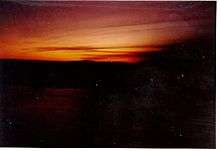
- See also: Hiking in the Nordic countries
Bitterly cold in winter, usually not very warm in summer, and sparsely populated, the main draws for visitors are the desolate yet majestic nature and the unparalleled opportunities for trekking and winter sports. Many businesses know how to help inexperienced foreigners enjoy their stay, e.g. arranging husky or snowmobile safaris, fishing trips, canoeing and northern light watching expeditions.
Several national parks can be found in Lapland with marked hiking trails and log cabins open to the public for free. But in contrast to Norway, they are only equipped with a stove and wood for heating, no food is provided. For the hardcore trekker there are wilderness areas, with even fewer people and services. To go on your own, basic hiking skills suffice in summer (be sure to know how to use a map and compass). During the spring floods and in winter you should have a guide on any longer trek unless you really know what you are doing.
Lapland is locally known for its fells (tunturi), but these are not any soaring mountains of the alpine kind, but gentle, rounded ones high enough to reach above the treeline (which is much below 1000 m at these latitudes). There are also vast forests and mires in hilly or flat terrain. In the northernmost regions (Utsjoki and Enontekiö) you will find also treeless areas, but real tundra is absent in Finland. The highest mountains are located in the "arm of Finland" in Enontekiö, but because of the location of the road right next to the fells, best views are actually towards Sweden. Still there are magnificent environments available for hikers!
Finland's highest mountain, Halti (1328m) in the farthest north west end of Lapland is not much more than a higher hill of loose rocks, the lower summit of a mountain with its top on the Norwegian side of the border. The surroundings are still very special and a popular, demanding destination. You are nowadays free to cross the border to Norway or Sweden and back where you want (customs formalities, if needed, can probably be taken care of beforehand).
For hikers, fishermen and hunters, there is a nice online map of Finland with most trails and huts marked, and a website about most important hiking terrains. Both are maintained by Metsähallitus, an agency that also administers the national parks.
There are of course also cultural events. You might want to attend the international Midnight Sun film festival of Sodankylä or Sámi events such as the St Mary's Day Celebrations.
Northern lights

Spotting the eerie northern lights (aurora borealis, Finnish: revontulet) glowing in the winter sky is on the agenda of many visitors. Northern Lapland is one of the best places to observe aurorae, as it has good accessibility, high-quality accommodation and a nearly continental climate with relatively clear skies. The probability of some northern lights is 50–70 % (most often between 10PM and midnight) any night with clear skies, and light pollution is quite easy to avoid here – but there are cloudy periods, so do not count on seeing them.
Also in southern Lapland, where probability is about 20 %, you might want to take a walk somewhere out of the light pollution any night with clear skies. If you do not spot northern lights, you will at least get a tremendous view of stars, compared to what you see in most cities.
To have a good chance to see northern lights you should stay at least a few days, preferably a week or more, in the far north in the right season. Probability for aurorae and clear skies varies somewhat from place to place, but all of northern Lapland, about from Sodankylä onwards, should be quite good. More importantly, as you need some luck and persistence, you want to go somewhere where you can enjoy yourself regardless. The ski resort of Saariselkä, easily accessible by plane and with plenty of facilities, is particularly popular among aurora hunters. If you enjoy wilderness and solitude, e.g. areas around Kilpisjärvi and Karigasniemi might be good choices. The village of Nellim is even more remote, being situated on the almost uninhabited eastern side of Lake Inari, where light pollution is at a minimum.
Cloudiness can be quite accurately estimated some hours, chance for major aurorae a few days in advance, so you can know when to go for a tour and when to spend the night in other ways – but as also minor aurorae are well visible in Lapland, you might want to be out any night with clear skies. Intense aurorae occur for 5–15 minutes at a time, so taking a look at the northern sky every now and then over a longer period will increase your chances.
Many businesses arrange northern light watching tours. Usually the tours also have some other theme, such that not seeing the aurorae will not spoil it, but taking care of being in the right place would the aurorae be visible. A week of backcountry skiing will offer even better opportunities unless you spend the best hours in your tent or a hut. A hotel in Kakslauttanen has glass-domed igloo rooms where you can watch northern lights indoors the whole night.
See Northern Lights for more detailed general advice.
Work
The ski resorts and many other tourist businesses depend on seasonal workers. As a significant part of the clients are from abroad, being a foreigner is not necessarily a drawback in getting jobs, especially if you know the right languages or cultures – as long as you have or can get a work permit, possibly with help from your to be employer. Skiing teachers, restaurant and bar personnel, entertainment, child care, what have you. Some jobs require formal qualifications or advanced skills and experience, while for some the right attitude will get you a long way, much more so than for most jobs in Finland.
Eat
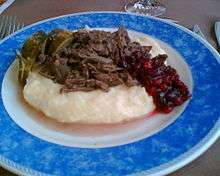
Lapland is the place to sample reindeer (poro) dishes, which are not too common elsewhere in Finland. The traditional way to eat this is as reindeer hash (poronkäristys), usually eaten with mashed potatoes and lingonberry jam.
Other Lappish specialities worth looking for are snow grouse (riekko), fish such as Arctic char (rautu), and the delectable cloudberry (lakka or hilla), the world's most expensive berry. It grows in swamps, unripe it is red, ripe it is light orange, it contains a lot of vitamin C. In shops you find it most likely as jam (lakkahillo).
Drink
Most nightlife is concentrated to Kemi and Rovaniemi, and especially at wintertime: to the skiing resorts!
When hiking in wilderness it is quite safe to drink water from rivers even without boiling. Most hikers use water also from small clear streams and lakes untreated, but you might want to boil that for a few minutes.
Sleep
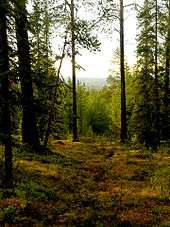
According to the Everyman's Right (jokamiehenoikeus) one can set up a "temporary" camp (at least a night or two) nearly anywhere in the forest or on the fell, no matter who owns the land. However, making a fire is allowed only in extreme occasions or by permission of landowner (as at campfire sites in national parks or by a general permit for some wilderness and backcountry areas – unless wildfire warnings are in effect) and in protected areas, such as national parks, there may be restrictions also on camping. At many hiking destinations there are Spartan open wilderness huts available for free or reservation huts for a very moderate price (€11/person/night, check where to get the key).
There are lots of good quality hotels and hostels around Lapland. At least for a longer stay or away from towns you might want to rent a cottage instead. Check the specific location; a search often suggests cottages that actually are a hundred kilometres from the intended destination.
Most accommodations also have programme services.
Stay safe
Know your limits. The winter environment is perfectly capable of killing the unwary tourist who gets lost in the fells. The rescue service works well – each year several tourists are rescued and only rarely any serious injury is sustained – but taking your chances is not recommended.
Avalanches are possible in winter. Check with the national parks or ski resorts and make sure you either know what you are doing or how to avoid affected areas, if venturing out in wilderness or on non-maintained slopes.
If you plan to travel alone or, for example in your own car, remember that distances are great and getting help for any unexpected situation may take time. Plan accordingly; take extra warm clothes in your car and tell the hotel staff where you are heading and when you expect to come back.
Also mind the hunting season: Natives are usually very keen of hunting, and the start of the season draws most hunters into the wilderness. Potential dangers can be countered by wearing a red cap or some other easily identified garment, and staying away from areas where hunting is allowed during the season.
When stopping on the road to enjoy the landscape, don't forget the traffic. Park at a safe spot and keep to the roadside.
Otherwise, there are few serious dangers to your well-being. Tap water and even water of lakes and creeks is potable (in most places, bottled water contains more harmful compounds than tap water) and foods are almost without exception safe to eat. Crime rates are low and people are helpful and nice in general but noisy foreigners on Friday night in a local pub/discothèque might be sitting ducks for harassment (in extreme cases; violent attacks) by drunken male villagers. This is mostly problem of skiing centres. Probability to get robbed or getting any other harm is still extremely low.
Go next
- Finnmark – the Norwegian equivalent, still more to the north, bordering the Arctic Ocean.
- Murmansk Oblast — though voyagers of most nationalities need a visa to visit Russia.
- Upper Norrland – the Swedish equivalent, with higher mountains.